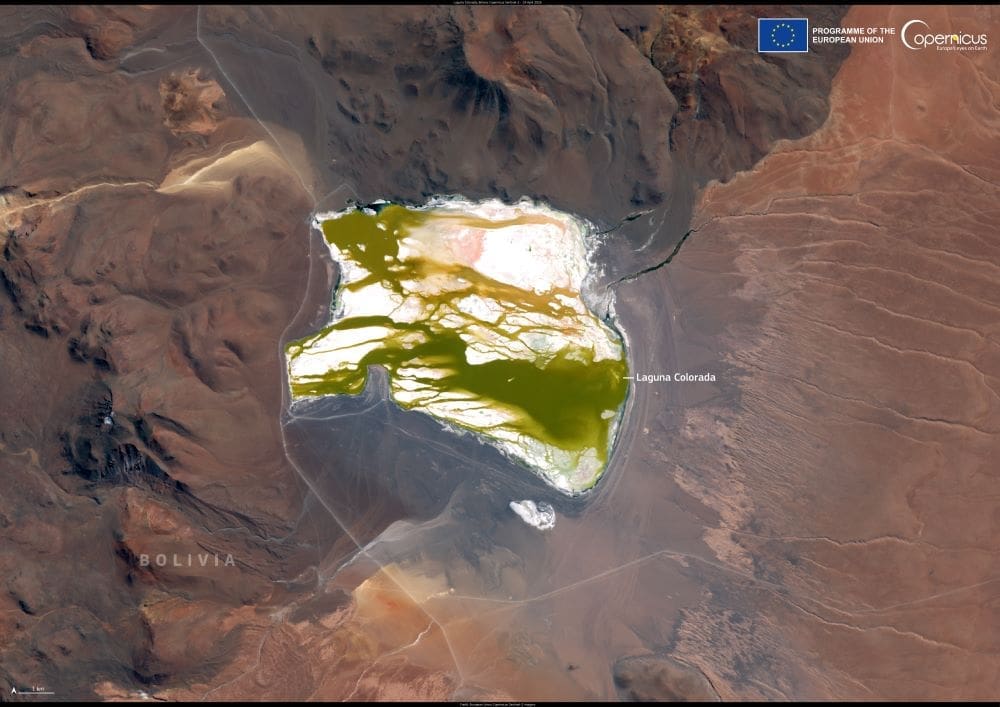Laguna Colorada, a striking shallow lake set high in Bolivia’s Eduardo Avaroa Andean Fauna National Reserve, has long fascinated scientists and travelers alike. Spanning roughly 60 square kilometres and sitting at an altitude of around 4,300 metres, the lake is celebrated not only for its otherworldly hues but also for its vital role in the survival of one of South America’s most iconic bird species.
Its waters, tinged red, green, or yellow depending on the mix of minerals and algae present, change appearance with shifting light and biological activity. On 19 April 2025, the European Union’s Copernicus Sentinel-2 satellite captured the lake bathed in a greenish-yellow tint, a reflection of the complex chemical interactions that shape this dynamic landscape. This spectral variation, visible from space, offers more than just aesthetic appeal – it provides valuable data for monitoring the health of ecosystems in remote and extreme environments.
Beyond its dramatic visuals, Laguna Colorada is one of the most important feeding and nesting areas for the endangered James’s flamingo (Phoenicoparrus jamesi), a high-altitude specialist found only in the Andes. These birds flock to the lake in large numbers, drawn by the abundance of microscopic organisms that thrive in its saline waters. Their presence is both a symbol of the lake’s ecological richness and a reminder of the fragility of such specialized habitats.
James’s flamingos, known for their pale pink plumage and vivid red legs, were once believed extinct until a small population was rediscovered in the mid-20th century. Today, conservationists continue to track their numbers closely, and sites like Laguna Colorada are essential to their future. The ability to observe these habitats remotely through satellite data has become an indispensable tool for biologists working to protect species under pressure from climate change and human activity.

The latest image from Sentinel-2 highlights not only the lake’s vivid palette but also the growing role of satellite technology in environmental science. Copernicus, the European Union’s Earth observation programme, makes its satellite data freely available, enabling scientists, policymakers, and conservationists to monitor water bodies across the globe. This open data stream supports efforts ranging from habitat protection to the assessment of pollution, land-use changes, and the impacts of warming temperatures.
In the case of Laguna Colorada, these observations help track changes in the lake’s water composition, surface area, and the seasonal dynamics that affect flamingo populations. Regular imaging allows researchers to detect subtle shifts that might not be visible on the ground, such as alterations in algal blooms that influence the birds’ food supply. By integrating satellite imagery with field data, scientists can build a more complete picture of how high-altitude wetlands function and how they are responding to environmental pressures.
Located within a protected reserve, Laguna Colorada remains relatively undisturbed by development, yet it is not immune to broader regional changes. Rising temperatures, shifts in precipitation patterns, and mineral extraction elsewhere in the Andean plateau all have the potential to affect the delicate ecological balance of these lakes. Tools like Sentinel-2 are proving essential for identifying emerging threats early and guiding strategies that aim to safeguard biodiversity across the Andes.
As this high-resolution snapshot reveals, even remote corners of the planet are deeply connected to global systems. Through regular monitoring, scientists can track the health of ecosystems like Laguna Colorada and work to ensure they continue to serve as havens for species like the James’s flamingo. In this way, satellite imagery is not just a lens into distant landscapes – it’s a window into the future of conservation.
Featured image credit: European Union, Copernicus Sentinel-2 imagery



